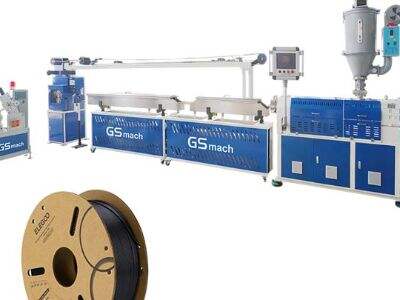อยากทราบเพิ่มเติมเกี่ยวกับโลกที่น่าสนใจของเทคโนโลยีการพิมพ์ 3D หรือไม่? เครื่องเหล่านี้เหมาะสำหรับคุณในฐานะมือใหม่ และ GSmach มีสิ่งที่ดีที่สุด การบีบอัดเส้นพลาสติก 3d เครื่อง สำหรับมือใหม่ หากคุณเพิ่งเริ่มต้นกับการพิมพ์ 3D อาจรู้สึกสับสนในช่วงแรก ซึ่งเป็นเรื่องปกติ นอกจากนี้ยังเป็นความรู้สึกทั่วไปเมื่อคุณเริ่มต้น แต่อย่ากังวล เราจะพาคุณผ่านเครื่องบีบอัดเส้นพลาสติก องค์ประกอบของเครื่องบีบอัด และให้คำแนะนำเกี่ยวกับสิ่งที่คาดหวังหลังจากเริ่มต้นใช้งาน
องค์ประกอบของเครื่องบีบอัดเส้นพลาสติก
ก่อนที่เราจะลงรายละเอียดเกี่ยวกับกระบวนการพิมพ์จริง ๆ มาดูส่วนสำคัญของเครื่องบีบอัดเส้นพลาสติกกันก่อน เพื่อให้คุณเข้าใจว่าแต่ละส่วนทำอะไร ส่วนสำคัญหนึ่งคือหัวบีบอัด ซึ่งเป็นที่ที่เส้นพลาสติกถูกหลอมละลายและคลายออก พลาสติกที่หลอมละลายแล้วจะถูกบีบผ่านหัวฉีดขนาดเล็ก เปรียบเสมือนการบีบยาสีฟันออกจากหลอด และจะถูกวางซ้อนบนเตียงพิมพ์ นี่คือวิธีการทำงาน เส้นฟิลAMENT จากเครื่องอัดรีด เครื่องจะทำงาน สร้างวัตถุ 3D ของคุณทีละชั้นอย่างช้าๆ พอให้รูปเงาดูเหมือนกับที่คุณออกแบบไว้
ตัวยึดสปูลเป็นอีกหนึ่งส่วนสำคัญของเครื่อง ส่วนนี้จะยึดม้วนเส้นพลาสติกให้อยู่ในที่เมื่อมันถูกโหลดเข้าไปในหัวฉีด ลองนึกภาพมันเหมือนอุปกรณ์ที่คุณใส่ม้วนลวดเพื่อใช้งาน เส้นพลาสติกจำเป็นต้องถูกป้อนเข้าสู่หัวฉีดอย่างลื่นไหล เพื่อให้การพิมพ์เกิดขึ้นโดยไม่มีปัญหา เครื่องพิมพ์เส้นพลาสติกยังต้องใช้ซอฟต์แวร์สำหรับการออกแบบงานพิมพ์และบอกเครื่องว่าจะต้องทำอะไร มันเหมือนกับโปรแกรมที่สามารถพิจารณาได้ว่าเป็นชุดเครื่องมือ ซึ่งคุณสร้างวัตถุที่ต้องการทำขึ้นมาได้ตามต้องการ
คู่มือง่าย ๆ สำหรับมือใหม่
ด้วยเหตุนี้ คุณก็รู้แล้วว่าส่วนสำคัญคืออะไรบ้าง ตอนนี้เรามาดูการทำงานของเครื่องพิมพ์เส้นพลาสติกทีละขั้นตอนกันเถอะ คุณจะต้องออกแบบมันผ่านซอฟต์แวร์ที่มากับเครื่องก่อน มีโปรแกรมมากมายให้เลือก และบาง เส้นฟิลลาเมนต์แบบอัด เครื่องจักรยังมีซอฟต์แวร์เฉพาะของตัวเองที่ติดตั้งอยู่ในอุปกรณ์ ซึ่งอาจทำให้คุณสามารถโอนแบบจำลองจากไดรฟ์ USB หรือ Wi-Fi เพื่อส่งไปยังเครื่องนี้ได้ นี่เป็นขั้นตอนสำคัญ เนื่องจากเป็นสิ่งที่บอกเครื่องว่าจะพิมพ์อะไร
จากนั้นคุณต้องดำเนินการและโหลดเส้นใยเข้าสู่เครื่อง ดังนั้นโปรดปฏิบัติตามขั้นตอนในคู่มือผู้ใช้อย่างละเอียดเพื่อไม่ให้เกิดข้อผิดพลาด มันเหมือนกับการทำตามรายการทีละขั้นตอนเมื่ออบเค้ก นอกจากนี้ อุณหภูมิของหัวฉีดจะต้องถูกตั้งให้อยู่ในช่วงที่เข้ากันได้กับประเภทของเส้นใยที่คุณใช้ เส้นใยแต่ละชนิดต้องการอุณหภูมิที่แตกต่างกันในการหลอมเหลวอย่างเหมาะสม ตอนนี้คุณพร้อมที่จะพิมพ์การออกแบบของคุณหลังจากโหลดเส้นใยและตั้งค่าทุกอย่างเรียบร้อยแล้ว
ปัญหาทั่วไปและวิธีแก้ไขที่ง่าย
บางครั้งปัญหาอาจเกิดขึ้นขณะทำงานกับเครื่องพิมพ์เส้นใย ซึ่งเป็นเรื่องปกติ แต่อย่ากังวลไป เพราะส่วนใหญ่ปัญหาเหล่านั้นสามารถแก้ไขได้อย่างง่ายดาย ปัญหาที่พบบ่อยคือการพิมพ์ที่ไม่สม่ำเสมอ ซึ่งหมายถึงว่าด้านใดด้านหนึ่งของวัตถุมีความสูงมากกว่าอีกด้านหนึ่ง สาเหตุหลักมาจากพื้นผิวในการพิมพ์ไม่เท่ากัน โต๊ะหรือพื้นผิวที่เครื่องอยู่ไม่แบน คุณสามารถตรวจสอบสิ่งนี้โดยการวัดด้วยไม้บรรทัดหรือฝ่ามือของคุณบนชั้นเพื่อดูว่ามันสมเหตุสมผลหรือไม่ หากไม่เท่ากัน ให้ปรับแต่งให้เหมาะสม นอกจากนี้คุณยังสามารถทดลองกับการตั้งค่าอุณหภูมิและความเร็ว เพื่อดูว่าจะเปลี่ยนแปลงอะไรได้หรือไม่
คุณอาจพบว่าหัวฉีดถูกอุดตัน ซึ่งเกิดขึ้นเมื่อเส้นใยพลาสติกติดอยู่ภายในเครื่องบีบและเครื่องไม่สามารถผลักมันออกมาได้ หลีกเลี่ยงปัญหานี้โดยการตรวจสอบให้แน่ใจว่าคุณใส่เส้นใยพลาสติกอย่างถูกต้อง และหากหัวฉีดเกิดอุดตันจริง อย่าตกใจ เพียงแค่ถอดมันออกอย่างระมัดระวังแล้วทำความสะอาดด้วยเครื่องมือขนาดเล็ก เช่น เข็ม มันเหมือนกับการทำความสะอาดหลอดที่ถูกอุดตัน การบำรุงรักษาจะช่วยให้การทำงานดียิ่งขึ้น:
เคล็ดลับสำหรับประสบการณ์ที่ยอดเยี่ยม
การดูแลรักษาเครื่องพลาสติกของคุณอย่างเหมาะสมเป็นสิ่งสำคัญเพื่อให้คุณสนุกกับการใช้งานและทำให้มันทำงานจนกว่าคุณจะได้การพิมพ์ที่ดีที่สุด สิ่งสำคัญคือต้องใช้งานอย่างถูกต้อง และเพื่อทำเช่นนั้น ควรปฏิบัติตามคำแนะนำในคู่มือผู้ใช้อย่างเคร่งครัดเสมอ ซึ่งสิ่งนี้ไปพร้อมกับการทำความสะอาดเครื่องของคุณอย่างสม่ำเสมอ ซึ่งเป็นสิ่งสำคัญมาก คุณควรทำความสะอาดฝุ่นหรือสิ่งสกปรกที่อาจเข้าไปในเครื่อง เพราะมันจะทำลายงานพิมพ์ของคุณ เช่นเดียวกับที่คุณไม่อยากให้มีฝุ่นในอาหาร คุณก็ไม่อยากให้มีฝุ่นในงานพิมพ์ 3D ของคุณเช่นกัน
มีฟิลาเมนต์หลายประเภทให้เลือก เช่น PLA และ ABS ฟิลาเมนต์แต่ละประเภทมีคุณสมบัติเฉพาะตัวและเหมาะที่สุดสำหรับโครงการประเภทต่างๆ PLA เป็นต้น ซึ่งเป็นตัวเลือกที่ดีสำหรับผู้เริ่มต้น เพราะใช้งานง่ายและให้ผลลัพธ์การพิมพ์ที่มีคุณภาพดี การลองผสมผสานฟิลาเมนต์เพื่อดูว่าแบบไหนเหมาะสมกับงานพิมพ์ของคุณมากกว่ากันนั้นเป็นเรื่องสนุก คุณอาจพบว่าชนิดหนึ่งเหมาะสำหรับการทำของเล่น ในขณะที่อีกชนิดหนึ่งเหมาะสำหรับการทำเครื่องมือ


